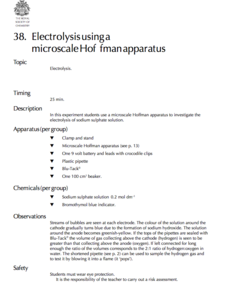Curated OER
Visualizing Vocabulary in an Ecosystem
Sixth graders observe the pond ecosystem. In this ecosystem lesson plan, 6th graders observe the organisms at the pond and create a poster that illustrates the pond.
Curated OER
Visual Arts Lesson: Pear-Shaped Bottle
Sixth graders examine how art from China arrived in Mexico during viceregal period, create blue monochromatic designs in wash by direct observation to illustrate simple objects from nature, and create vase or bottle shape that...
Curated OER
Observing Weather
Students investigate the weather by reading children stories. In this weather observation instructional activity, students read Cloudy With a Chance of Meatballs and several other stories about weather before they create a KWL chart....
San Francisco Symphony
Instrument and Visual Appreciation of Art
There are a lot of great ideas to be found here. To better understand the connection between art and history, learners research several music and art pieces, then relate them to major social events. They study the lives and works...
Royal Society of Chemistry
Electrolysis Using a Microscale Hoffman Apparatus—Microscale Chemistry
Get big results out of a small-scale lab! Young chemists observe the electrolysis of sodium sulfate using a microscale experiment. A colorful indicator solution combined with the production of gas bubbles yields a variety of observations...
Curated OER
Form and Observation
Use a familiar song and adorable baby animal pictures to teach youngsters about genetic variation. Begin by listening to "Twelve Variations on 'Ah vous dirai-je Maman,'" which you will need to find online (there are several versions...
Concord Consortium
Visualizing Electric Fields and Forces
Shock your class with an exciting interactive about electric fields! Physical science superstars visualize the transparent world of electric fields by changing the charge on a stationary object. They then observe changes in the resulting...
Curated OER
The Importance of Observation
First graders practice observing items in small areas. In this scientific observation lesson, 1st graders complete a worksheet that shows a child looking at a small patch of grass. They make a list of items that the child sees. They...
Curated OER
Let's Go Shopping
Pupils explore how to become better observers, demonstrate point of view as a literary and human function, and learn an important lesson about how to explain differing perspectives in the same situation.
Curated OER
Seashell Painting
Let nature inspire your budding artists. They paint seascapes on actual seashells. First, they observe the seaside, then they paint what they see (image or in person) on the inside of a white shell.
Curated OER
Who Will Get the Job?
Seventh graders demonstrate their ability to identify interview skills that lead to success in the job-seeking process by participating in and observing an interview with an employer. Students also use a checklist to validate their...
Curated OER
Cornmeal with Powder Paint
Pre schoolers use art to build observational skills and eye-hand coordination. They squeeze art into a ribbon like shape on their paper, then sprinkle cornmeal and powder paint over it. They watch as water is sprayed on top of the...
Curated OER
Investigate Pine Creek!
Students are invited to become detectives in this Web-Integrated Science Environment (WISE) as they explore a local creek, its environment and ongoing status. Students participate in field trips, acquisition of data through water testing...
Curated OER
Crepe or Tissue Paper Blots
What happens when you drip vinegar onto tissue paper? The colors bleed, leaving an interesting and organic design. Get your class observing and creating with this quick-and-easy art project. Tip: This can also be done using coffee...
Curated OER
Comparing the Amoeba to Paramecium
This laboratory activity is valuable practice in comparing features of different organisms. You could use it to introduce junior biologists to protozoans. The materials and procudures for the learners are simple, and analysis questions...
Curated OER
A Hidden Beauty
Expose the beautiful mystery of bulbs as young botanists learn all about these fascinating plants. They glean information from a short text before observing actual bulbs (consider an onion), and comparing their findings with predictions....
Perkins School for the Blind
Conductors of Heat - Hot Spoons
Why is the end of a spoon hot when it's not all the way in the hot water? A great question deserves a great answer, and learners with visual impairments will use their auditory and tactile senses to get that answer. A talking...
Mobile Education Store
ConversationBuilder
Some students struggle in social situations or when it comes to conversing with peers. Conversation is key in developing relationships and in building strong social skills. This app can be used to help children with social anxiety, ASD,...
Teaching for Change
Selma in Pictures: Socratic Seminar
Photographs from the freedom movement in Selma, Alabama serve as the basis of two Socratic Seminars. Class members prepare for the seminars by closely observing the images, form a hypothesis, and use evidence from photo to support a...
Curated OER
Visual Patterns in Tessellations Worksheet
In this tessellations worksheet, students name 3 items that have tessellating patterns. Students then use the interactive tessellating program found at www.shodor.org to draw and answer 5 questions about their tessellations.
Curated OER
Leaf Prints
Creating art from nature teaches learners how to appreciate the world around them while allowing them to practice artistic techniques. After observing and choosing fall leaves from outside, they create leaf prints. They press the painted...
Math Worksheets Land
Interactive Equivalent Fractions
Visual learners will benefit from this approach to teaching equivalent fractions, completing problems in multiple steps to observe the process more clearly. They complete eight problems.
Math Drills
Color Fraction Strips With Labels
See how many halves, fifths, and twelfths are in a whole with a colorful set of fraction strips. Kids can observe strips that are the same size, and decide how many of each fraction they will need to complete a whole.
National Wildlife Federation
The Water Cycle
Observe the water cycle from the comfort of your classroom with this excellent earth science experiment. Working collaboratively, young scientists first create terrariums complete with hills, plants, lakes, and an atmosphere,...

























